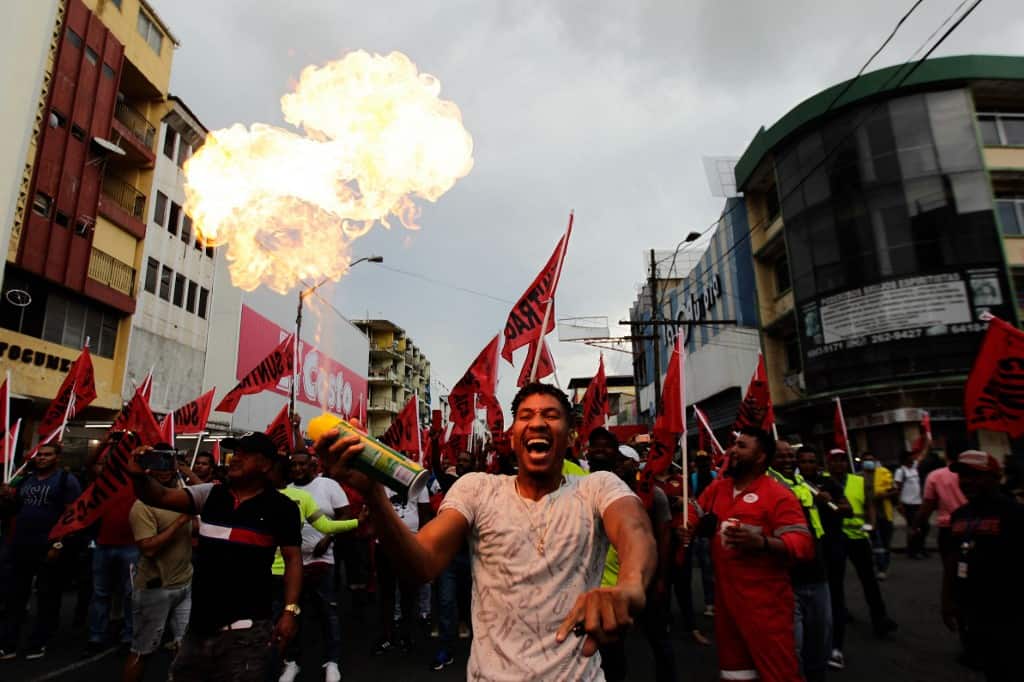“The cost of living is what has the people on the streets, the people are asking for social justice,” Sergio Gallegos tells AFP.
He is one of the thousands of people who have protested in the last two weeks to demand the government to intervene and contain the prices of basic food basket products and medicines.
The protests have led to the closing of public schools, suspension of transportation and calls for strikes. The UN office in Panama called on the parties to “seek consensus”, while the Catholic Church offered to mediate in the conflict.
For the most part, the marches have been in a festive atmosphere of dancing and chanting, although the police reported the arrest on Wednesday of 24 people for “demonstrations and acts of vandalism” in Panama City.
The discontent comes against a backdrop of 4.2% year-on-year inflation recorded in May and an unemployment rate of around 10%. In addition, the price of fuel has increased by 47% since the beginning of the year, and is currently worth US$5.17 per gallon of gasoline (3.78 liters).
During the protests, the Interamerican highway, a vital route for the connection with Costa Rica and the transport of goods throughout Panama, has been partially closed.
The situation has set off alarm bells for the government and businessmen, who fear millions of dollars in losses and see trade, tourism and economic recovery threatened after the pandemic.
“The problems are not only of one sector. The problem is for all Panamanians who are suffering”, warns the indigenous and general Guna chieftain, Rengifo Navas.
Panama is experiencing one of the greatest social crises since the military dictatorship of General Manuel Antonio Noriega fell in 1989 after the US invasion.
“We are in an unprecedented social outburst,” Enoch Adames, professor of sociology at the University of Panama, told AFP.
The protests forced President Laurentino Cortizo on Monday to reduce the price of fuel to $3.95 per gallon as of Friday.
Social Justice in Panama
“Discontent is widespread and repudiation of the government is universal,” adds political scientist and historian at Florida State University’s Panamanian branch, Carlos Guevara-Mann.
With a dollarized and service-based economy, an inter-oceanic canal -which contributes more than US$2 billion annually to the national treasury-, high economic growth rates and alternation in power, Panama has experienced relative stability since 1989.
The Panamanian economy grew by 17.8% in 2021 and 13.6% in the first quarter of 2022.
However, the country has one of the highest rates of inequality in the world, with half of informal employment and public health and education services with major deficiencies.
“The social outburst is strongly conditioned by the structural crisis, both of the growth model without development and by a political order of privileges highly concentrated in resources and decisions,” says Adames.
“There is an accumulation of unsatisfied demands which is what has given rise to the protests, but the trigger has been fuel prices”, adds Harry Brown, director of the International Center for Political and Social Studies, to AFP.
For Brown, the Panamanian protests are similar, in objectives, to those that occurred recently in Ecuador, Colombia and Chile. “We can place them in the context of the demand throughout the region for a better distribution of wealth.”
Frustration in Panama
In addition to the reduction in the price of gasoline, Cortizo also pledged to freeze the price of a dozen basic products, to reduce the expenses of civil servants and to cut by 10% the number of public workers.
“How he (Cortizo) pretends that with 10 foods of the basic basket that he wrote down we are going to be able to subsist, it is impossible”, laments to AFP the student, Wendy Ramos.
The unions are asking Cortizo to make greater efforts, despite the fact that the public debt accumulated by 2022 could exceed 44 billion dollars.
Criticism has also increased against the salaries of authorities, corruption scandals and expenses of parliamentarians, some of whom were involved in the controversy for a video in which they appear celebrating with a whiskey whose value is around 400 dollars.
“There is a deep component of social dissatisfaction and frustration with the degradation and corruption of a greedy and rapacious political class,” says Guevara-Mann.
The demonstrations occur at a time when Cortizo is facing a cancer in his blood. The president has two years left in office in the midst of uncertainty.






